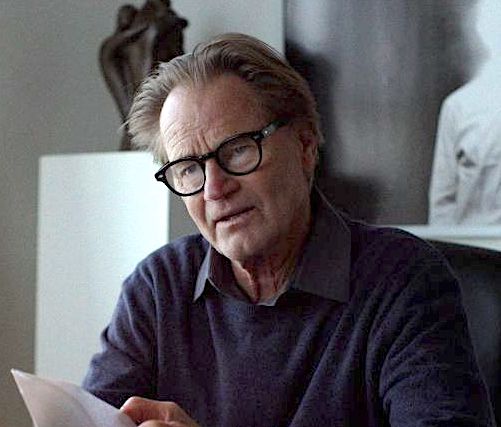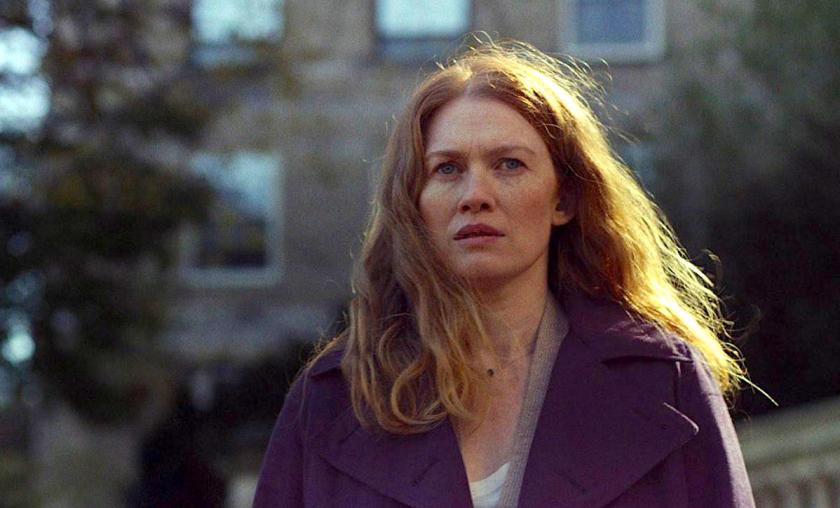Beware the hidden powers of the cellphone. When in Never Here New York conceptual artist Miranda Fall (Mireille Enos) finds a stranger’s phone, she uses it as the basis for her next art show, tracking down and interviewing the owner’s contacts, listening to his music and using his GPS history to retrace his steps. She lives in a private bubble of self-regard, and is shocked when her subject is hurt and angered by her crass exploitation of his privacy. “You’ve done a bad thing,” he tells her at the show’s launch party.
Miranda comes out with fatuous nuggets of pseudobabble like “circumstances are the dictators of my work”, but it seems she’s managed to upset the karmic balance within her previously cosy little sphere of activity. When a woman – one of her neighbours, as it turns out – is assaulted in the street outside her apartment building, the event is witnessed by her lover and art dealer Paul Stark (Sam Shepard, pictured below, quietly authoritative in his final film role). Paul is married to an invalid wife, and to protect him Miranda claims to the police that it was she who saw the attack. This puts her in the absurd position of describing the attacker from Paul’s description of him, and then attending a police line-up to identify a suspect she’s never seen.
However, never satisfied with a silly idea when she could embrace a really stupid one instead, she becomes intrigued by one of the men in the line-up parade after she thinks she’s seen him at her exhibition. She starts following him around the city obsessively with her video camera, treating the viewer to episodes of wobbly stalker-vision in the process. Miranda, the artist-as-vampire, decides he must become the subject of her next “project”.
 If you think none of this looks likely to end well, you’re on the right track. Miranda’s life starts to slide into a Hitchcockian twilight of mysterious intruders and misleading identities, where it isn’t clear whether she’s truly in peril or whether she’s experiencing some sort of psychological disintegration. Perhaps both. Director Camille Thoman, making her feature film debut, doesn’t hide her debt to ol’ Hitch, and as well as including a clip from The Lady Vanishes has named one of her characters after its star Margaret Lockwood.
If you think none of this looks likely to end well, you’re on the right track. Miranda’s life starts to slide into a Hitchcockian twilight of mysterious intruders and misleading identities, where it isn’t clear whether she’s truly in peril or whether she’s experiencing some sort of psychological disintegration. Perhaps both. Director Camille Thoman, making her feature film debut, doesn’t hide her debt to ol’ Hitch, and as well as including a clip from The Lady Vanishes has named one of her characters after its star Margaret Lockwood.
Themes of voyeurism and intimate violations of private spaces help to raise the emotional temperature, while Thoman’s knack of shooting her actors so their identity remains tantalisingly ambiguous amplifies the sense of unease and insecurity. “I am disappearing, Andy,” wails the desperate Miranda to her detective-boyfriend Andy Williams (Vincent Piazza), whose investigation of the assault case gives the narrative an additional twist. James Lavino’s creepy, fragmented piano score feels subtly unhinged, and Einos skilfully imparts the sense of a woman cllnging to a cliff edge by her fingernails.
Thoman’s film doesn’t help itself with intermittent lapses into the perverse and the impenetrable rather than the merely mysterious, and at 110 minutes it’s crying out for a trim. There’s something about it that keeps you hanging in there, though.
Watch the trailer to Never Here













